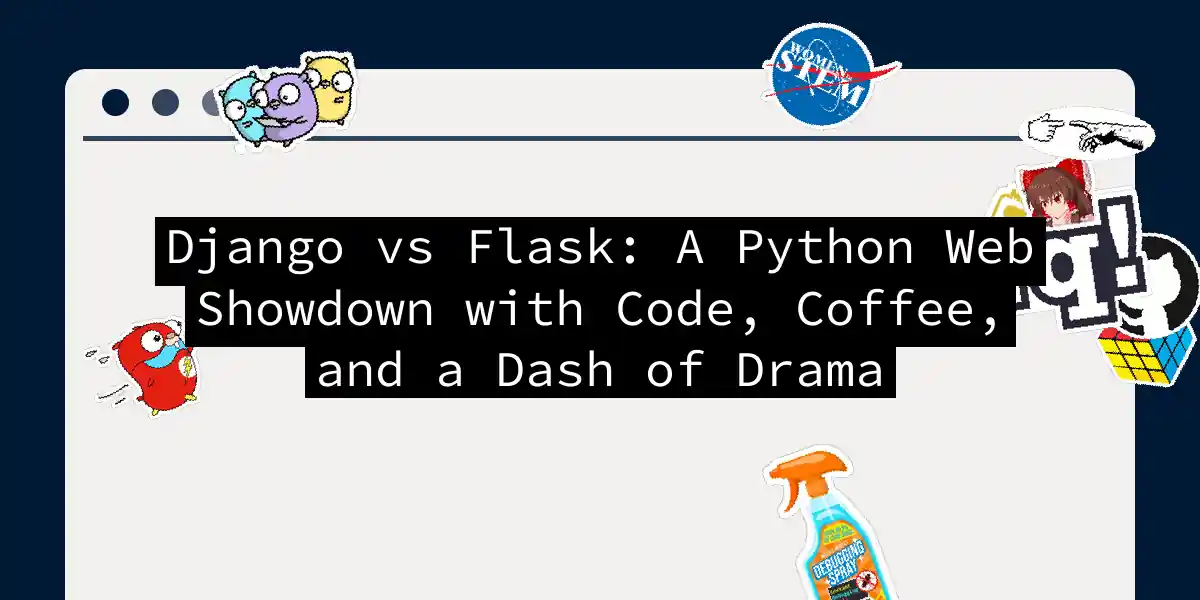Picture this: You’re standing at a developer crossroads. On one path - Django, waving its “batteries-included” banner. On the other - Flask, casually leaning against a “micro-framework” signpost. Which way to go? Grab your caffeinated beverage of choice, and let’s dissect these Python web titans with surgical precision (and maybe a dad joke or two).
The Contenders: Framework Philosophies
Django is the over-prepared friend who brings a camping stove to a picnic. Born in 2005 to handle newspaper deadlines, it’s the framework that says “Why build an admin panel when I’ve already baked you one?”
# Django's "Hello World" (with free admin dashboard)
from django.http import HttpResponse
def hello(request):
return HttpResponse("Welcome to Web Development: Easy Mode")
Flask is the minimalist artist of the Python web world. Created in 2010 as Django’s leaner cousin, it’s perfect when you want to say “I’ll take web serving with a side of creative freedom, please.”
# Flask's barebones approach
from flask import Flask
app = Flask(__name__)
@app.route('/')
def hello():
return "Welcome to the Wild West of Web Dev"
Round 1: Development Speed vs Flexibility
Django’s “magic” comes at a price - you need to learn its incantations. But once you do:
# Django ORM model that generates DB tables auto-magically
from django.db import models
class CoffeeDrink(models.Model):
name = models.CharField(max_length=200)
intensity = models.IntegerField(default=3)
created_at = models.DateTimeField(auto_now_add=True)
# Boom! Admin interface appears like Hogwarts magic
Flask keeps it real with SQLAlchemy:
# Flask-SQLAlchemy setup
from flask_sqlalchemy import SQLAlchemy
db = SQLAlchemy()
class CoffeeDrink(db.Model):
id = db.Column(db.Integer, primary_key=True)
name = db.Column(db.String(200))
intensity = db.Column(db.Integer, default=3)
created_at = db.Column(db.DateTime, server_default=db.func.now())
Pro Tip: Choosing between them is like picking between a buffet (Django) and à la carte (Flask). Just don’t be that developer who uses Flask for an e-commerce site - that’s like bringing a spoon to a sword fight.
Round 2: Scalability Smackdown
Django’s built-in async support (since 3.0) lets you handle parallel requests like a pro:
# Django async view
async def latest_coffee_news(request):
return await render_async(request, 'news.html')
Flask keeps it lightweight but can scale with proper architecture:
# Flask with Gunicorn workers
gunicorn app:app -w 4 -k gevent
The Verdict: When to Use Which
Choose Django if:
- You enjoy built-in admin panels that make you feel like a wizard
- Your project has “enterprise-scale” written all over it
- You want security features out-of-the-box (XSS/CSRF protection included) Reach for Flask when:
- You need a prototype faster than coffee cools
- You want to mix and match components like a web dev bartender
- Your project is smaller than my tolerance for JavaScript frameworks True Story: I once built a Flask MVP for a coffee shop API in 2 days… then spent 2 weeks trying to add features Django would’ve included. Lesson learned - don’t be a framework hipster.
Final Brew Thoughts
Both frameworks will get your web app served hotter than fresh espresso. Django is your full-stack bestie, Flask your minimalist companion. My advice? Learn both - they’re like Python’s yin and yang. Now if you’ll excuse me, I need to debug this Django middleware… and by “debug” I mean “make another coffee.” ☕
